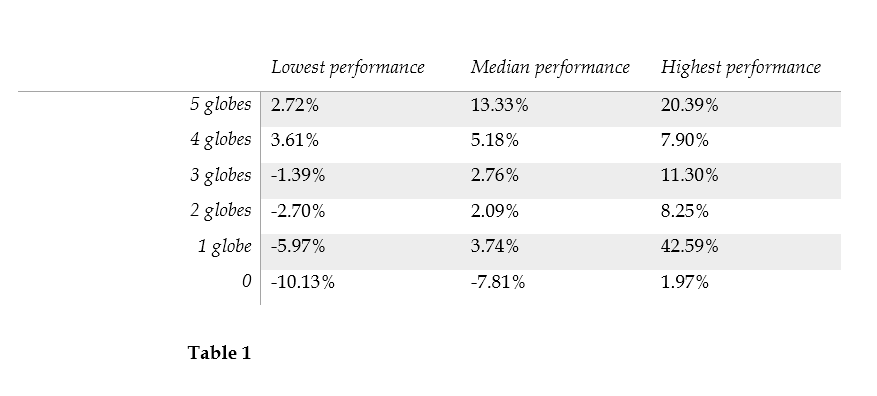Last year, the Government Pension Fund of Thailand’s (GPF) 1-billion-baht ESG-focused portfolio recorded a ten-month return of 4.6%, surpassing its main equity fund by 50bp. “In the long run, we strongly believe the ESG index will outperform broad equity indices due to lower business and operational risks,” says Arsa Indaravijaya, assistant secretary general, research and investment strategy group, Government Pension Fund. “To a greater extent, ESG portfolios will also outperform their corresponding ESG indices. This is from perspectives of conservative and transparent business and financial policies, competitive standpoints, lower portfolio volatility, and more sustainable business model. Those limit issues relating to regulatory, social and environment.”

There is also anecdotal evidence of ESG-enhanced performance in Asia. More than half (57%) of 127 Asian fixed income investors surveyed in 2020 by Asset Benchmark Research (ABR) said that integrating ESG into their investment process enhanced the long-term risk-adjusted return of their portfolios. However, almost two thirds (63%) complained that there were insufficient ESG assets in their markets.
In an ABR survey last year, 66% of more than 200 fixed income investors active in Asian G3 fixed income said they were incorporating ESG into their fundamental analysis indicating that sustainability is playing an increasingly significant role in portfolio construction.
However, the same survey also presents a more nuanced picture of ESG investment motives. While 13% said that outperformance was one of the top three drivers to incorporating ESG into their credit risk analysis, other factors were also taken into account notably client demand (28%), fiduciary duty (23%), regulation (21%) and risk management (14%).
The results send a clear message: a significant proportion of investors in the region are still questioning whether ESG can deliver in performance terms. This doubt inhibits asset managers from integrating ESG factors into their investment strategies and product offerings. As a result, fewer ESG fund products in Asia have track records to verify the notion of “doing well by doing good”. In short, it is a chicken and egg problem.
However, more evidence is coming to light. With the broad market sell-off in Q1 2020, Covid-19 has provided an opportunity to verify if environmental, social and governance (ESG) investing can outperform in a down market. As the dust settles and market sentiment normalizes, green shoots have emerged from the ESG investing world, with investors doubling down on sustainability during the pandemic.
“In Asia ex-Japan, even with the deterioration in markets, ESG assets are actually up 21% in the first quarter, and this has also been supported by really strong performance from sustainable funds,” observes Gabriel Wilson-Otto, head of stewardship, Asia-Pacific at BNP Paribas. This runs counter to historical precedents Wilson-Otto notes. In times of adversity, investors could normally be expected to focus on short-term profits rather than sustainability.
Enhanced performance To examine the relationship between sustainable investing and risk adjusted returns, ABR analyzed the three-year annualized performance of 137 UK-offered public mutual funds invested in Asian equities. The data suggests that sustainable investing consistently outperforms and generates better risk-adjusted returns. The median score of performance shows that funds with the lowest ESG risk (5 globes) outperform those with a high ESG risk (zero globes). (See graph 1)
The median three-year annualized performance increases as the ESG rating increases, apart from the anomaly of the 1 globe fund. The median of the 5 globe funds is 13.33%, which is significantly higher than that of the anomalous 1 globe funds. This confirms that sustainable investing can generate better risk-adjusted returns in the long-term on average.

In terms of the consistency of performance, funds with higher ESG ratings deliver positive three-year annualized returns (see table 1). The 5 globe equities funds deliver a performance range from 2.72% to 20.39%. The 4 globe funds enjoy performances from 3.61% to 7.9%. The rest of the categories of funds deliver fluctuating performances with the 1 globe funds showing the most extreme variations (-5.97% to 42.59%). Funds that receive zero globes perform the worst in general, delivering 1.97% at best and -10.13% at worst.
The data shows that funds with fewer ESG risks are performing better in delivering consistent mid- to long-term returns. Though the evidence is not exhaustive, it suggests that ESG investing in the Asian context delivers promising returns consistently in the long term. And as sustainable investment grows in Asia, there will be more data as well as anecdotal evidence to solve the chicken and egg problem.
Methodology
The ABR team compares the three-year annualized performance of public mutual funds investing in Asian equities with different ESG ratings offered in the UK. Through the Morningstar fund selector platform, there are 137 public mutual funds investing in Asian equities. The three-year annualized performance and Morningstar sustainability ratings are used for generating the above results.
The three-year annualized performance is chosen for comparison because it is a good indicator of mid- to long-term fund performance, which also captures the fund’s return under the recent Covid-19 situation.
The Morningstar sustainability rating is used as there are no better alternatives. Its data is based on Sustainalytics’ ESG Risk Rating. A portfolio score (Morningstar Portfolio Sustainability Score) is calculated on an asset-weighted basis. Then each portfolio will receive a Historical Portfolio Sustainability Score by taking the weighted average of the trailing 12 months of Morningstar Portfolio Sustainability Scores.
Within their Morningstar Global Categories, provided that a category has at least 30 portfolios, portfolios are assigned according to the 5 globes system with the best 10% of portfolios receiving 5 globes, the next 22.5% receiving 4 globes, next 35% receiving 3 globes, next 22.5% receiving 2 globes and the worst 10% receive one globe. Funds without globes are unrated.

By grouping the fund performances according to their ESG ratings, we will have 6 distributions of fund performances invested in Asian equities










